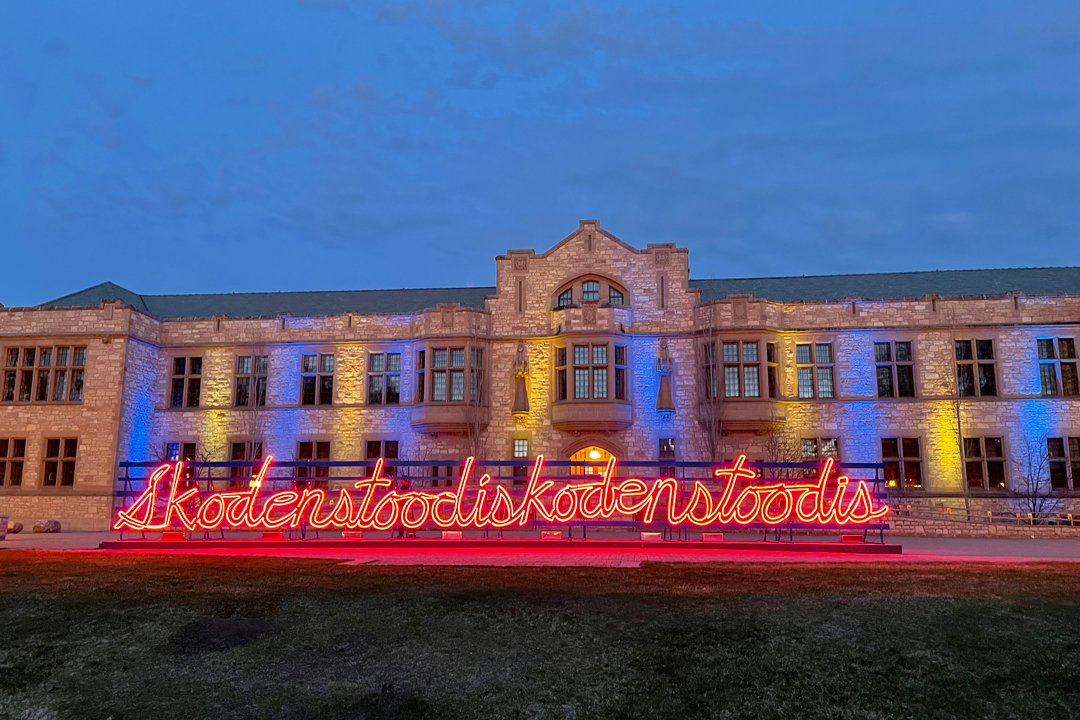
Exploring Indigenous identity and resistance
USask graduate and visual artist Wally Dion (BFA’04) returns to campus for skodenstoodis, a major solo exhibition at the College Art Galleries
By Shannon Boklaschuk
Visitors to the University of Saskatchewan (USask) are sure to notice skodenstoodis.
The 58-foot-long neon sculpture, created by visual artist Wally Dion, was installed this month outside the Peter MacKinnon Building, in the Nobel Plaza facing The Bowl area. When lit at night, the glow of the neon is reminiscent of a fiery prairie sunset—a nod to a sense of place, perhaps, but created with a modern aesthetic that contrasts the stonework of the National Historic Site, built between 1910 and 1912.
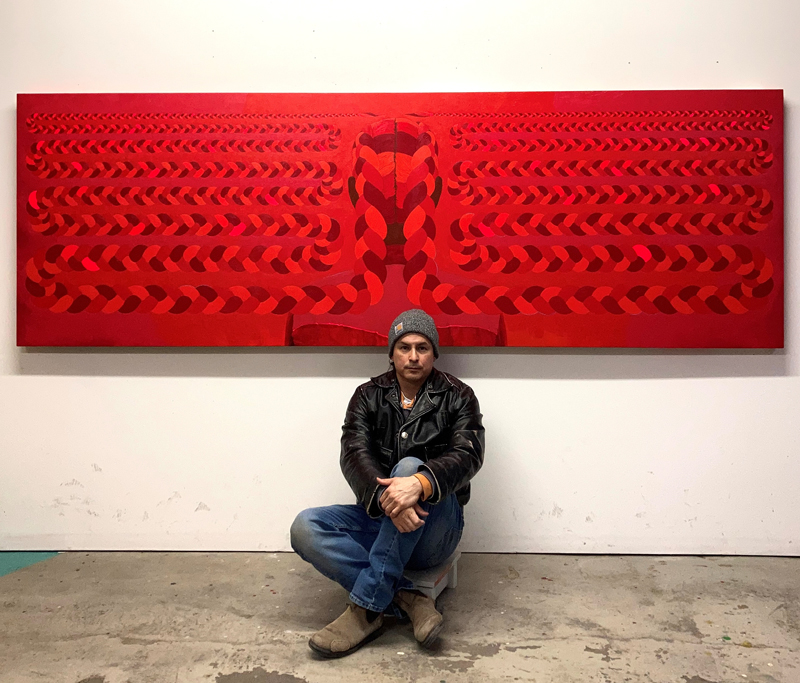
It’s a surprising but fitting placement for the sculpture, as contradictions can often be found throughout Dion’s artwork and throughout his new solo exhibition. The show, also titled skodenstoodis, opens on May 13 at USask’s College Art Galleries, with an artist’s talk and reception, and runs until Aug. 26, 2022.
For Dion, a USask graduate and member of Yellow Quill First Nation (Saulteaux) who currently lives in Binghamton, NY, the exhibition marks a return to his artistic roots. He has fond memories of his time as a student in USask’s College of Arts and Science, where he earned a Bachelor of Fine Arts (BFA) degree in 2004. Dion takes a trip down memory lane as he recalls his BFA show at USask’s Gordon Snelgrove Gallery and his classmates in the Department of Art and Art History—among them artists Joi Arcand (BFA’06) and Zachari Logan (BFA’05, MFA’09) and curator Leah Taylor (BFA’04).
“This is where it all started,” he said.
Since graduating from USask, Dion has earned a Master of Fine Arts degree from the Rhode Island School of Design and has received national and international acclaim. His artwork is included in numerous permanent collections—including the collections of the Saskatchewan Arts Board, the Canada Council Art Bank, the MacKenzie Art Gallery, Remai Modern and Portland Art Museum—and he is known as an advocate for Indigenous artists. One of his most high-profile artworks is Star Blanket, an Indigenous star blanket fashioned from an unconventional material—computer circuit boards—that was purchased by the Saskatchewan Arts Board in 2006. Star Blanket has been showcased in galleries throughout Canada and, when it isn’t on loan, is displayed in Saskatchewan’s Legislature Building.
Despite currently living and working in a small city in Upstate New York, Dion maintains close ties to Saskatchewan. As a youth, he grew up attending art lessons at the Mendel Art Gallery, once situated across the river from USask, and he worked with Saskatoon Community Youth Arts Programming Inc. (SCYAP) as an adult.
More recently, Dion served as an artist-in-residence at Wanuskewin in 2021. His artwork, Steel Star, was also featured in Next Year’s Country, a recent Remai Modern exhibition that examined history and place through Canadian artworks housed in the museum’s permanent collection. Steel Star is now one of the 15 pieces featured in skodenstoodis, a show that highlights Dion’s new and recent artworks and includes the site-specific large-scale neon sculpture as well as painting, drawing and circuit board assemblages.
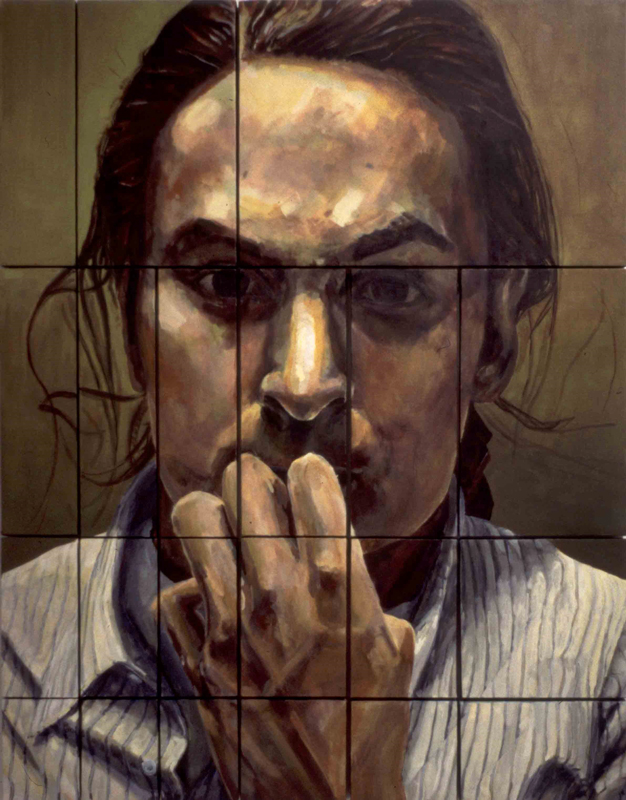
When he was invited by Taylor to show his work at the College Art Galleries, Dion said he thought of fellow USask graduate and artist Lori Blondeau (MFA’03), whose survey exhibition, Grace, curated by Taylor, was showcased in the same gallery spaces in 2018.
“I was wondering how I could continue that energy that she had in here,” he said.
Taylor, who has known Dion for nearly 20 years, is also the curator for skodenstoodis. She’s watched as Dion’s artistic career has gone on “to see incredible national and international success,” but believes skodenstoodis will still be “a significant hometown exhibition” for him.
“He is an impressive artist, but also a community advocate, providing leadership in the arts for Saskatchewan, so we are really honoured to host his major solo exhibition in the College Art Galleries at USask,” she said.
In a recent interview a few days before the exhibition’s opening, Dion sat in front of one of his artworks, titled red braids, and reflected on the multiple meanings and contradictions inherent in his work. He created red braids after the death of Colten Boushie, a young Indigenous man who was fatally shot on a Saskatchewan farm in 2016.
Dion’s painting depicts the back of a person’s head, with flowing, intricate braids on either side. As he created it, he thought about the violence involved in shooting someone and the vulnerability of the back of a person’s skull (he also noted the individual in the painting represents gender fluidity rather than the dichotomies of maleness or femaleness).
“Originally I painted the back of the head, and I was thinking of the violence against Indigenous people with bullets,” he said. “I guess I was asking the question, ‘How could anyone feel comfortable, or how could it happen, just to shoot somebody, to shoot an Indigenous person?’ ”
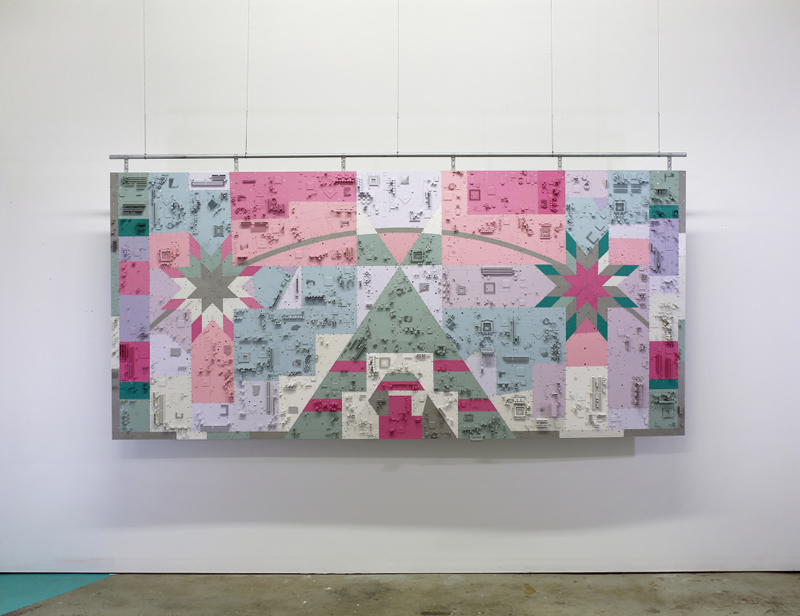
With red braids, Dion also contemplated the significance of braided hair to Indigenous culture and the strength in celebrating traditional ways of being and doing. For Indigenous people, wearing braids can be both an act of self-actualization and an act of resistance, he said, noting Indigenous children were forced to wear their hair short in residential schools. For Indigenous people today, braiding one’s hair can be a way to push against these colonial policies and a means to fully represent one’s true self, said Dion.
“By braiding their hair, sometimes people just want to become who they are.”
Dion also contemplated the contradictions inherent in the braids themselves. When braids are pulled too tightly against the scalp, for instance, they cause pain and discomfort. Yet when someone braids another person’s hair, it’s often done as an act of love and received as an act of trust.
“Somebody has to stand or sit behind you and braid your hair, so it’s also maybe a little bit of a gift that you would give to somebody every day,” he said.
Upstairs from red braids, in College Art Gallery 1, some of Dion’s artwork takes on an uncomfortable, and contradictory, beauty. For example, two pieces featuring prehistoric-looking fish highlight Dion’s respect for the natural world; yet, upon closer inspection, viewers see that his sea creatures are carefully crafted from discarded computer circuit boards. The juxtaposition of nature with the human-made e-waste evokes commentary about the impact that technological production and copper mining has on the environment.
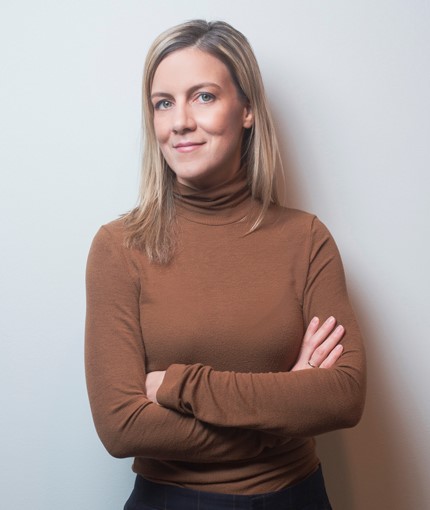
Taylor noted that in other artworks in the same space, the circuit boards are “assembled to incorporate Indigenous patterning that acknowledges the importance of traditional craft and the skill found within these practices.”
“This body of work also interrogates the increasing rate of resource extraction necessary to produce these technologies and the environmental implications,” she said.
Outside the galleries sits the largest artwork in the exhibition, the neon text-based sculpture skodenstoodis. Again, Dion portrays contradiction in his work; at first glance, the bright cursive letters can seem playful and fun, perhaps conjuring images of youthful pleasures at arcades and carnivals. But Dion deliberately chose the sculpture’s cursive text to highlight another aspect of youth: the conformity of the classroom. In residential schools, Indigenous children were forced to turn away from their languages and read and write in English. As a result, the sculpture is mounted on long blue beams, representing the lined notebooks found in school classrooms.
Taylor said the sculpture “operates as a call to action, by both uplifting and challenging the institution’s role as a space of teaching and learning.”
“The artwork considers themes surrounding Indigenous language and learning, with specific relation to Wally’s personal, lived experience with assimilation in colonial education systems,” she said. “Skodenstoodis is a combination of two Indigenous slang root words: ‘skoden,’ meaning ‘let’s go then,’ and ‘stoodis,’ meaning ‘let’s do this.’ The scale of the neon is meant to reflect standing human scale when the viewer approaches it; at six feet tall and 58 feet in width, it holds a significant visual space that won’t be missed by a passerby.”
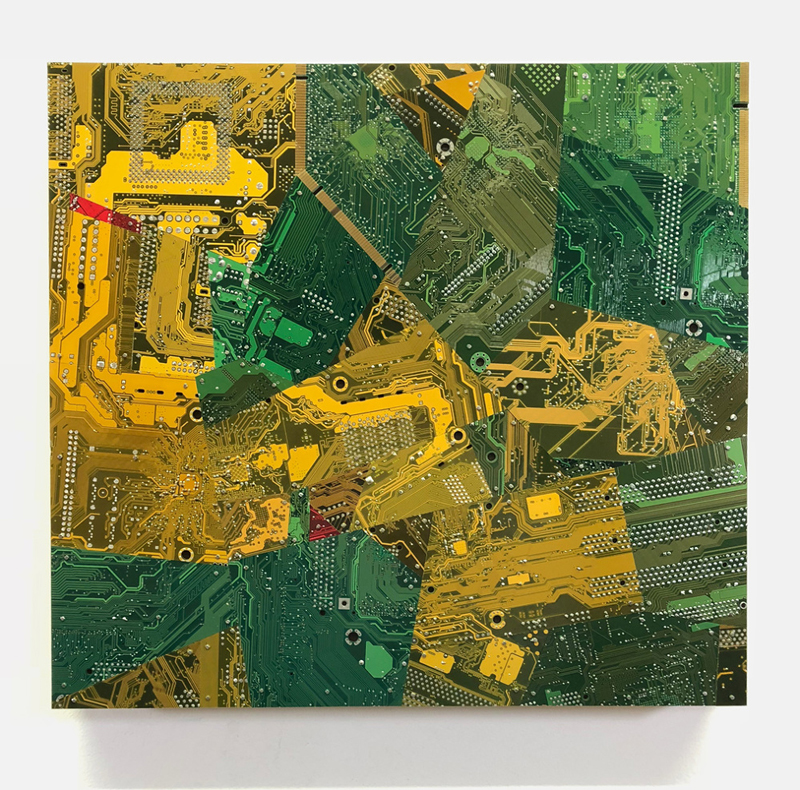
Despite the serious themes of skodenstoodis, Dion said there is some humour in the sculpture—something he feels Indigenous viewers will appreciate. “Skoden” and “stoodis” were part of viral online meme culture, and memes can make people laugh while also serving as a powerful means of resistance. Dion said that by using “skoden” instead of “let’s go then,” and “stoodis” instead of “let’s do this,” Indigenous people are showing the world that assimilation doesn’t work.
“I think that’s how Indigenous people would and could frustrate the system,” he said. “They know exactly what you’re asking and what you want to do—and we just do it a little different way.”
Through skodenstoodis, Dion also wants to make a joke about the trend of putting long traditional Indigenous names near pathways and other landmarks. He chose a long word for the sculpture—“skodenstoodiskodenstoodis”—which he believes some people may assume is “just another Indigenous word for this area or the tree or the grass.”
“It’s just a joke,” said Dion. “But it’s like a puzzle—because when Indigenous people see it, they know instantly what it is; they can see the words in there. It’s just a tongue-in-cheek way of potentially bringing other people and other cultures into Indigenous humour, which I think is a really clever way of bringing people together instead of pushing people apart.”

